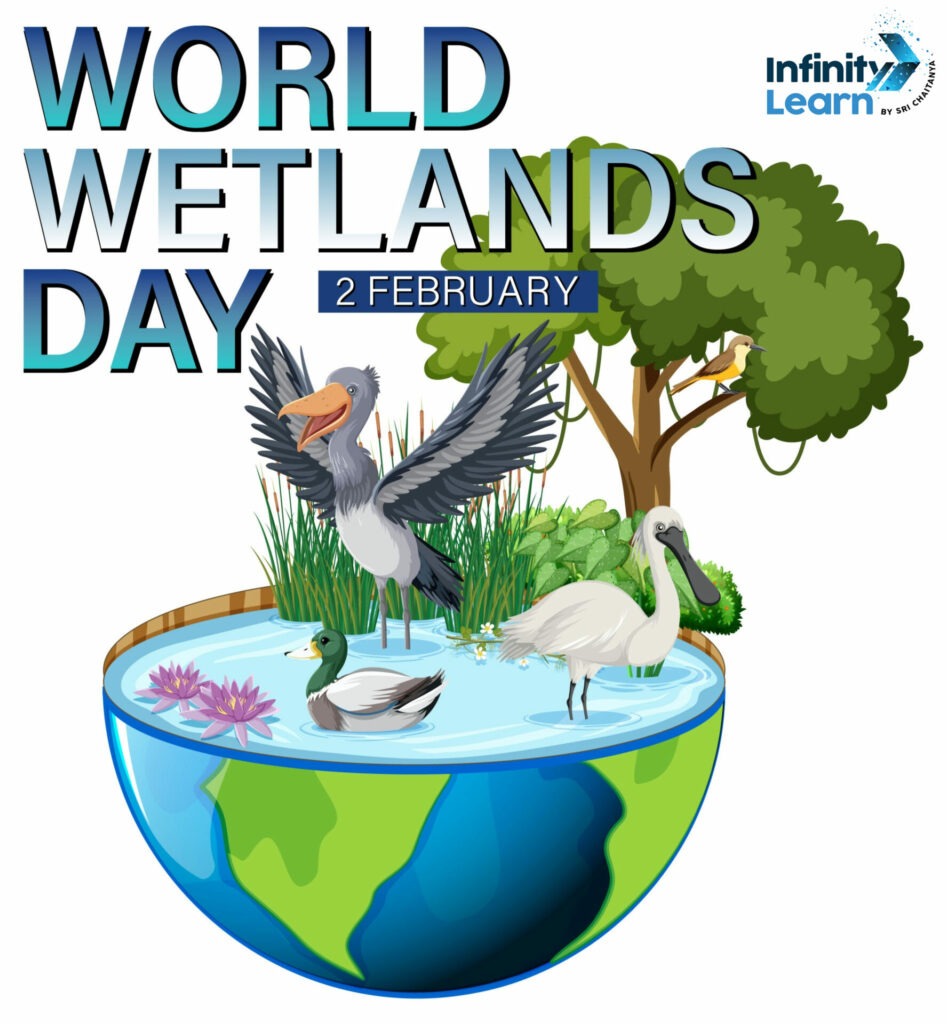Table of Contents
Every year, World Wetlands Day is celebrated on February 2nd to raise awareness about the crucial role wetlands play in sustaining biodiversity, water resources, and climate regulation. World Wetlands Day 2025 highlights the need for bold actions to protect these valuable ecosystems for the benefit of future generations.
This day marks the anniversary of the Ramsar Convention, an international treaty signed in 1971 in Ramsar, Iran, dedicated to the conservation of wetlands. World Wetlands Day 2025 emphasizes global cooperation in preserving wetlands and their ecological importance.
World Wetlands Day 2025

World Wetlands Day Theme 2025
The official theme for World Wetlands Day 2025 is “Protecting Wetlands for Our Common Future.” This theme urges governments, communities, and individuals to take decisive action in conserving and restoring wetlands to secure a sustainable future.
With the 15th Meeting of the Conference of the Contracting Parties to the Convention on Wetlands (COP15) scheduled for July 2025 in Zimbabwe, this year’s theme aligns with the global agenda to protect wetlands from degradation.
World Wetlands Day themes for 2025, 2026 and 2027
World Wetlands Day has been observed annually on February 2nd since 1997. The celebration was initiated following Decision 19.10 at the Standing Committee’s 19th meeting in 1996, where all Contracting Parties were encouraged to organize national events and activities to raise awareness about wetland conservation. This global event remains the most significant platform for educating the public on the vital role wetlands play in biodiversity, climate stability, and human well-being.
Themes and Global Outreach
Each year, World Wetlands Day follows a dedicated theme that underscores the importance of wetlands for both people and the planet. The Secretariat develops informational and outreach materials in the official languages of the Ramsar Convention, ensuring widespread engagement. These resources support Contracting Parties and partner organizations in their awareness-raising efforts.
Additionally, the Secretariat conducts a global outreach campaign to amplify the event’s impact worldwide. Since its inception in 1997, Danone has consistently funded the development and production of materials for World Wetlands Day, enhancing its visibility and effectiveness.
Criteria for Theme Selection
The Standing Committee selects annual themes based on key criteria, including:
- Alignment with the Conference of the Contracting Parties (COP) theme
- Relevance to UN-declared environmental themes
- Emphasis on critical benefits of wetlands
- Connection to current global scientific and policy discussions
By adhering to these guidelines, World Wetlands Day themes remain relevant, engaging, and impactful, helping to mobilize diverse stakeholders and encourage action.
Proposed Themes for 2025, 2026, and 2027
The Standing Committee is tasked with finalizing the upcoming themes for the next three years. Early theme selection allows Contracting Parties, the Secretariat, and partner organizations to plan and execute campaigns effectively. The proposed themes include:
- 2025: Protecting Wetlands for Our Common Future (Aligned with COP15)
- 2026: Wetlands for Sustainable Cities
- 2027: Wetlands and Indigenous Knowledge: Preserving Cultural Heritage
Previous themes for World Wetlands Day
| World Wetlands Day Theme Year | Theme |
|---|---|
| World Wetlands Day Theme 2024 | Wetlands and Human Wellbeing |
| World Wetlands Day Theme 2023 | Wetland Restoration |
| World Wetlands Day Theme 2022 | Wetlands Action for People and Nature |
| World Wetlands Day Theme 2021 | Wetlands and Water |
| World Wetlands Day Theme 2020 | Wetlands and Biodiversity |
| World Wetlands Day Theme 2019 | Wetlands and Climate Change |
| World Wetlands Day Theme 2018 | Wetlands for a Sustainable Urban Future |
| World Wetlands Day Theme 2017 | Wetlands for Disaster Risk Reduction |
| World Wetlands Day Theme 2016 | Wetlands for Our Future: Sustainable Livelihoods |
| World Wetlands Day Theme 2015 | Wetlands for Our Future |
| World Wetlands Day Theme 2014 | Wetlands and Agriculture: Partners for Growth |
| World Wetlands Day Theme 2013 | Wetlands Take Care of Water |
| World Wetlands Day Theme 2012 | Wetland Tourism: A Great Experience |
| World Wetlands Day Theme 2011 | Forests for Water and Wetlands |
| World Wetlands Day Theme 2010 | Caring for Wetlands – An Answer to Climate Change |
| World Wetlands Day Theme 2009 | Upstream, Downstream: Wetlands Connect Us All |
| World Wetlands Day Theme 2008 | Healthy Wetlands, Healthy People |
| World Wetlands Day Theme 2007 | Fish for Tomorrow? |
| World Wetlands Day Theme 2006 | Livelihoods at Risk |
| World Wetlands Day Theme 2005 | There’s Wealth in Wetland Diversity – Don’t Lose It |
| World Wetlands Day Theme 2004 | From the Mountains to the Sea – Wetlands at Work for Us |
| World Wetlands Day Theme 2003 | No Wetlands – No Water |
| World Wetlands Day Theme 2002 | Wetlands: Water, Life, and Culture |
| World Wetlands Day Theme 2001 | A Wetland World – A World to Discover |
| World Wetlands Day Theme 2000 | Celebrating Our Wetlands of International Importance |
| World Wetlands Day Theme 1999 | People and Wetlands – The Vital Link |
| World Wetlands Day Theme 1998 | Importance of Water to Life & Role of Wetlands in Water Supply |
| World Wetlands Day Theme 1997 | WWD Celebrated for the First Time |
Significance of Wetlands
Wetlands are among the most productive ecosystems on Earth, providing a range of ecological services, including:
- Water Filtration – Wetlands act as natural filters, removing pollutants from water.
- Biodiversity Hotspots – They provide habitat for diverse species, including migratory birds, amphibians, and fish.
- Flood Control – Wetlands absorb excess rainwater, reducing the risk of floods.
- Climate Regulation – These ecosystems capture carbon and help combat climate change.
- Livelihood Support – Millions of people depend on wetlands for fishing, farming, and tourism.
Threats to Wetlands
Despite their importance, wetlands are disappearing at an alarming rate. Studies show that 64% of the world’s wetlands have vanished since 1900 due to:
- Urbanization and Industrialization – Expanding cities and infrastructure development destroy wetland areas.
- Pollution – Industrial waste, plastic, and agricultural runoff degrade wetland ecosystems.
- Climate Change – Rising temperatures and extreme weather events affect wetland biodiversity.
- Deforestation – The clearing of vegetation disrupts wetland hydrology.
How is World Wetlands Day 2025 Celebrated?
Governments, NGOs, schools, and environmentalists worldwide organize events, awareness campaigns, and restoration activities to celebrate World Wetlands Day 2025. Some key activities include:
- Educational Programs – Schools and universities conduct seminars, debates, and workshops on wetland conservation.
- Clean-Up Drives – Volunteers participate in wetland restoration projects and waste clean-ups.
- Policy Discussions – Leaders and policymakers discuss strategies to implement the Ramsar Convention guidelines.
- Social Media Campaigns – Online platforms share facts, infographics, and calls to action under hashtags like #WorldWetlandsDay and #WetlandsForFuture.
The Role of the Ramsar Convention
The Ramsar Convention on Wetlands, signed in 1971, plays a significant role in wetland conservation efforts. It provides a framework for countries to designate Ramsar Sites—wetlands of international importance. Currently, over 2,400 Ramsar sites worldwide are under protection.
How Can You Contribute to Wetland Conservation?
Individuals can actively contribute to wetland conservation by:
- Avoiding Plastic Waste – Reduce single-use plastics that pollute wetlands.
- Supporting Sustainable Agriculture – Encourage eco-friendly farming practices that minimize pesticide runoff.
- Participating in Wetland Restoration – Join local conservation groups to protect wetlands in your region.
- Spreading Awareness – Educate others on the importance of wetlands and advocate for their protection.
Conclusion
World Wetlands Day 2025 serves as a crucial reminder of the importance of wetlands in maintaining ecological balance. As climate change and human activities continue to threaten these ecosystems, urgent global action is needed to ensure their survival.
By raising awareness, implementing policies, and engaging in conservation activities, we can protect wetlands for future generations. Let’s commit to preserving these vital ecosystems and securing a sustainable future for all.
World Wetlands Day 2025 FAQs
What is the theme of World Wetlands Day 2025?
The theme for World Wetlands Day 2025 is Protecting Wetlands for Our Common Future.
What is the theme of World Wetlands Day 2024?
In 2024, the theme was Wetlands and Human Wellbeing, highlighting the link between wetlands and human health.
Which day is celebrated as World Wetlands Day?
World Wetlands Day is celebrated annually on February 2nd.
What is the message of World Wetlands Day?
The day emphasizes raising global awareness about the vital role of wetlands for people, nature, and the planet.








